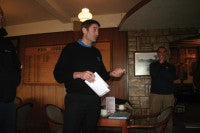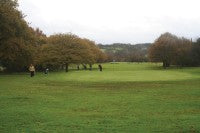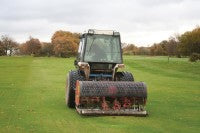Penn Pals!
 Paul Mills has been Course Manager at Penn Golf Club for just nineteen months. Previously he was deputy head greenkeeper at Stratford Upon Avon Golf Club and, before that, a greenkeeper at Bloxwich Golf Club. He has a team of four to assist him, Assistant Course Manager, Adam Jones, and greenkeepers Keith Swann, Phil Nixon and Paula Colley
Paul Mills has been Course Manager at Penn Golf Club for just nineteen months. Previously he was deputy head greenkeeper at Stratford Upon Avon Golf Club and, before that, a greenkeeper at Bloxwich Golf Club. He has a team of four to assist him, Assistant Course Manager, Adam Jones, and greenkeepers Keith Swann, Phil Nixon and Paula Colley
When Paul arrived at Penn he found unmanaged heathland areas and loss of habitat, issues that needed to be rectified as soon as possible.
As a member of the recently formed Midlands Gingerbread Men, Paul has been able to call on their support whilst he undertakes these difficult tasks.
 In a relatively short space of time the fruits of his labours are already being seen and, whilst there is still a long way to go, he has found the support of the 'Gingers' invaluable.
In a relatively short space of time the fruits of his labours are already being seen and, whilst there is still a long way to go, he has found the support of the 'Gingers' invaluable.
As a young greenkeeper he is only too aware that he still has a lot to learn, and it is this learning process that resulted in Jonathan Wood, Course Manager at Enville Golf Club, organising a visit by the 'Gingers' to offer support and advice. These include greenkeepers from The Chase, Bewdley Pines, Trentham and Ombersley golf clubs who walked the course to see what Paul had already achieved. He takes up the story.
"The greens are soil push up, with the exception of the 3rd which is part soil push up and part sand. Soil is generally heavy throughout the site, with underlying clay.

I inherited predominantly annual meadow grass greens with the usual problems: high organic matter levels which made them susceptible to disease, shallow root growth and poor draining.
They performed okay in the summer but, beyond that, were pretty poor. The collars, fairways and tees all suffered with similar thatch problems.
I have plenty of experience of managing Poa greens, but I had long decided that, when I got my chance to become a course manager, I would not be managing my course in that way.
My team and I set about rectifying these problems by adopting a very austere management programme, primarily on the greens, to try and change the species composition to Bent and Fescue.
We have, pretty much, done it by the 'Jim Arthur' book, but are, now, also under the guidance of STRI's Andy Cole.

There has been a notable change in species composition, drainage, firmness and resistance to fusarium. Because of our austere approach we have had outbreaks of Anthracnose. Two applications of fungicide have been applied this calendar year to combat that.
In the last nineteen months we have deep scarified three times, using the Graden, regularly aerated with our vertidrain and sarrel spiked, combined with minimal irrigation, regular topdressing and major reductions in the amount of feed put on. We have found that the sarrel spiking has been an excellent way of keeping the surface open.
This year we are using just fifteen units of Nitrogen (down thirty-five on the previous year's fifty units), consisting of lawn sand, 8:0:0 organic seaweed and iron.
This will, hopefully, see our organic matter percentages fall from around the 11-14% in the 0-20mm range, closer to our targets of 5-7%. This range is our main problem area with figures through the rest of the profile not far off target.

Heights of cut on the greens is 4mm in the summer and 6mm in winter. We haven't verticut but we have groomed them regularly, and are just about to introduce brushing.
We have tried not to compromise in any area with regards to setting the right conditions for finer grasses to thrive.
Our last overseed with pure brown top bent was successful and we will aim to overseed two or three times a year.
The work has been to the detriment of the putting conditions, with green speeds running between seven and nine feet on the stimp but, using the STRI's trueness meter we would probably be between five and six on the scale for the worst greens and seven on the better ones. Double cutting for priority events has enabled us to produce a decent surface.

Tees are scarified once a year and deep tined twice. The feeding programme is along the same lines as the greens. This year we have used Primo Maxx, with added potassium nitrate, which has meant that we have only had to mow tees once a week.
Aprons and fairways are vertidrained twice, with just the aprons receiving a feed. Fairways receive no feed.
Woodland management has been little to non existent, as has the management of the deep rough areas which are turning rank and degenerate in places, inhabited by undesirable species such as yorkshire fog.

We have removed around fifty conifers and lombardy poplars with the aim of returning the heathland characteristics to the common. We are entering into a Higher Level Stewardship scheme with Natural England to aid us with the heathland restoration and the creation of a grassland management programme, which has been inspired by the good work being done at our near neighbours, Enville Golf Club. John Handley of ALS has been very encouraging and helpful in this cause, composing a species list for the common.
We have some wonderful flora with harebell, marsh orchids, bog bean and a vast amount of sedges, some extremely rare. They just need a chance to thrive!"
